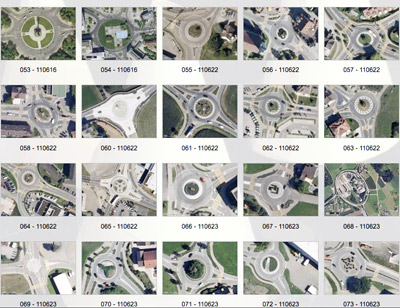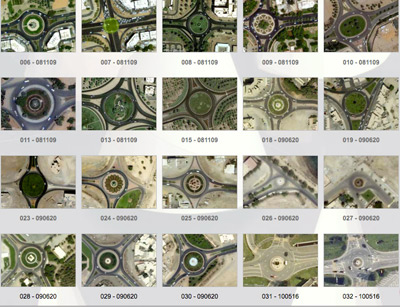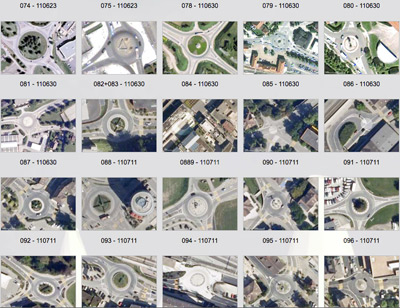Drivers’ comment
Going Around
on Hannes Brunner´s Driver´s comments
A trip, explains Paul Virilio (*), is composed of three parts: the departure, the path or trajectory, and the arrival. According to Virilio, today we experience the dominance of the arrival over the other elements of a journey or voyage. The acceleration of time in communication and transportation in our period results in a loss of spatial extension: “real time” has absorbed space, in the same way that an absolute present, the “now”, exemplified by the immediacy of digital communication and of virtual models or virtual worlds, is in the process of absorbing the past and the future.
The result is a time without dimensions, concomitant to a space without boundaries or configurations ensuing not from unlimited physical expansion, but from speed and the contraction of our experience of distance, and therefore of our experience of place, and ultimately of physical space as such.
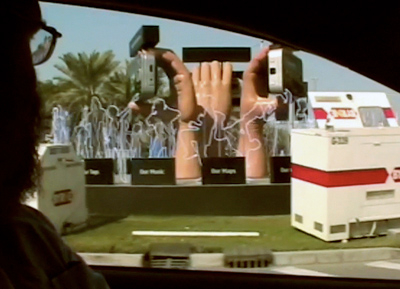
Marcelo Lima, Arts and Art Historian in Dubai, Roundabout in Media City, Dubai, 2009
In a world transformed by technology art becomes, according to Virilio, a strategy of resistance against the losses that technical transformations impinge upon human reality and experience: there is a price to be paid for every technical conquest and as much as the benefits of technical progress are in one way or another self-evident, it is the role of artists and thinkers to dwell in the negative of unintended (or unstated intended) consequences of poorly mastered or unmastered, that is, autonomous (J. Ellul) technical developments.
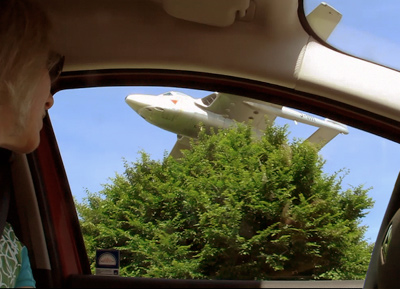
Corinne Schatz, Independent Curator, St.Gallen Switzerland; Roundabout in Altenrhein, SG Switzerland, 2011
Traffic circles in Europe as in the UAE display what we may call public artworks, monuments, and also advertising and other kinds of visual as well as textual messages. Categories that are sometimes amalgamated in the uncertain species of these sculptural or three dimensional structures in highways and cities´routes, these hybrid (?) super-objects (or meta-objects), these large significant objects, that is, these public conveyers of meanings associated with place and with the functions and the experiences of the modern road transport systems and their related urban and non-urban spaces.
In the figure of the circle departure and arrival points coincide: a homogeneous or homogenized space corresponds to equally homogeneous time of general equivalences, repetitions, co-incidences, and tautologies. Traffic circles are points of confluence of paths, they can be seen as points of arrival and departure of trajectories, they are intersections and points of relay, separating and uniting itineraries and directions, mapping and remapping dynamic routes, they are also kinds of spatial interfaces designing territorial synapses, virtual encounters and evanescent, momentary, unstable configurations of experienced pathways, of time and distance.
Traffic circles structures are markers in an undifferentiated or poorly differentiated continuum and homogeneous time. How to understand them? In Hannes Brunner´s “Driver´s comments” we circle around roundabouts, the driver notes forms, associations, gives captions to images seen within the frame of a car´s window, moving images of an animated, recurring landscape or town-scape, in which all the circles are one. The driver brings categories: art-historical, cultural, aesthetic, symbolic, etc. that belong most probably to another “space”, to other kinds of objects, to another kind of “territorial” experience and another experience of time, incongruous to the objects and situation of a traveler or a user of the modern highway system. The driver speaks from a position of estrangement that is both internal and external to his temporary functional identity.
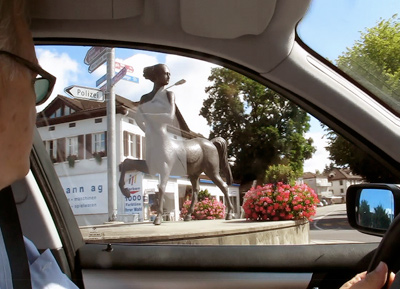
Nikolaus Wyss, Anthropologist and ret. Dean of the Academy of Fine Art and Design Lucerne; Roundabout in Müllheim, TG, Switzerland, 2011
The messages of traffic circle structures are addressed to the passerby, that is to the newcomer, the “foreigner”, the territorial other that needs to be informed about where he is, both in practical as well as in symbolic terms. In the road we are simultaneously within and outside a location, within the road, out of the place, entering or leaving, both entering and leaving at the same time. We are dis-placed. The driver reads the itinerary directly or indirectly via the messages of traffic circles. What do they say? Not much in relation to what they allude to, whether local histories and local identities, national symbols, or expressive configurations of modern experience such as leisure, “culture”, etc, relatively more about functional spatial organization, speed and efficiency, etc. associated with the transport system itself. Traffic circles speak of... traffic as spectacle, they speak of the modern experience of the spectacle in the form of highways, auto-mobiles, mapped territories, rationalized spaces and rationalized time, in their own ways they speak of the spectacle itself as the exclusive horizon of modern experience.
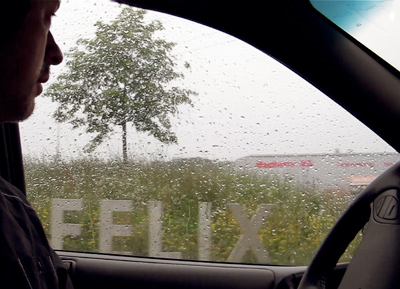
Alberto Alessi, Architect SIA, Zürich; Roundabout in Arbon, TG, Switzerland, 2011
The driver´s comments, being displaced in form and substance, speak about displacement itself. The road is a space of passage, and therefore a non-place, if by place we define a meaningful relatively stable space of experience, the experience of relative constancy of the self, of relative continuity of time related to the environment, physical and symbolic, to a situated structure of being, to the structural, constitutive exchanges between subject and milieu.
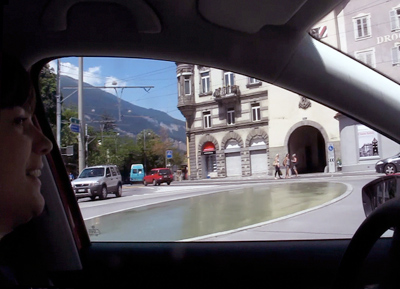
Katharina Ammann, Curator at the Museum dRoundabout in Chur, Switzerland dRoundabout in Chur, Switzerland d`art dal Grischun, Chur, Switzerland; Roundabout in Chur, Switzerland 2011
Monuments mark territorial centers of interest defining sacred, social, political, etc. spaces, defining inclusion and exclusion, group identity and others. Traffic circles monuments report on the utopia ( literally, the non-place, the nowhere) of the present, the extended non-place we inhabit as itinerant dwellers of an accelerated time and an undifferentiated space. Paradoxes: an accelerated time becomes a contracted time, a time without dimensions; an overextended space becomes a contracted space, a symbolically unstructured space open therefore to the phantasies of meaning. Traffic circles name our general displacement, they gently disclose or exemplify the anxiety of naming, the textual anxiety of labeling the territory as a way of access to a meaning that has escaped the subject.
The road returns to the driver its own image: traffic circles “artworks”, emblems, visual structures speak of a certain nostalgia of time, they speak of the disappearance of the landscape, including the historical landscape, in itself a phantasy of history, they speak about the modern phantasy of the traveler, the phantasy of being self in the guise of other, and vice-versa.
*Virilio, Paul – The Politics of the Very Worst, Semiotext, New York, 1999
Project by Hannes Brunner, Switzerland, (Europe+Emirates, 2009/11)
Text copyright © Marcelo Guimarães Lima, 2011
RELATED WEB SITES
→ author’s blog
→ author’s blog
→ artist’s site
→ project’s site, videos
[ A Stroll through Cairo and Time ]
[ Capital Presents ]
[ cheek ]
[ Dispositions ]
• Drivers’ comment •
[ E’laan—Call for Job ]
[ Going for a Ride ]
[ Of Huts and Tents ]
FEATURED THEME ON CITY SHARING
by ASUNCION MOLINOS GORDO
-
This project is an instrument for common critical analysis to help understand the reasons behind Egyptians’ diminishing …
by INAS HALABI
-
The project Letters to Fritz and Paul focuses on the expeditions of the Swiss cousins, lovers and scientists, Fritz and …
by SARAH BURGER
-
The planned modern city of Brasilia attracted me since a long time. Her defined shape, location and function proceded he …
by ADRIEN GUILLET
-
Youri Telliug talks with the artist Adrien Guillet about his project Citracit
Youri Telliug - What is Citracit …
by NIGIST GOYTOM
-
In 2013 more than 45 million people have been forced to leave their homes. This amounts to the biggest number of refugees …
by SULAFA HIJAZI
-
The on going debate on Arab identity and its (cultural) representation is strongly shaped by Edward Saidʼs formative …
by ASUNCION MOLINOS GORDO
-
WAM is a site-specific work that uses the historical trope of the cabinet of curiosities to explore the introduction of …
MORE CONTRIBUTIONS BY THE FOLLOWING
